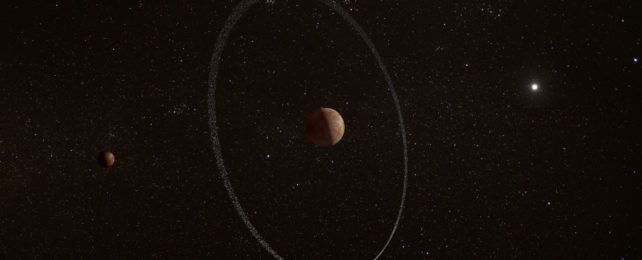
Rings in the Solar System are not exactly rare. Half the planets have them, and others may have in the past. Some asteroids have rings, as does the dwarf planet Haumea. Even the Sun has rings of a sort.
Now astronomers have found an entirely new ring system. Only this one has left them scratching their heads, as it's unlike anything else in the Solar System.
Quaoar, a small dwarf planet that hangs out in the Kuiper Belt beyond Pluto, is also circled by a dense ring – a ring circling at a distance so great it should still be stuck together as a moon.
The discovery means that scientists may need to revise our understanding of how moons and rings form and are affected by the gravitational interaction with their larger companion.
Quaoar, measuring just 1,110 kilometers (690 miles) across, was discovered in 2002 and, over the years, has turned out to be quite the interesting little ball of rock. It shows signs of ice volcanism, and it even has a cute little moon called Weywot, just 170 kilometers across.
But in 2021, astronomers noticed something else. They were watching as Quaoar, a dark shadow in the far reaches of the Solar System, moved into position to obscure a star way off in the far distance, a type of observation called an occultation. Observations from a ground-based telescope in Australia suggested that the dwarf planet might be harboring a ring.
Led by astronomer Bruno Morgado of the Federal University of Rio de Janeiro in Brazil, a team of astronomers went looking to see if they could find more evidence. But you can't just, you know, point a telescope at a tiny dwarf planet in the deep darkness of the Kuiper Belt and hope to make out any detail, never mind seeing the rings themselves.
Instead, the researchers had to rely on data collected by multiple ground-based telescopes between 2019 and 2020, looking for more occultations, as well as observations on the occultation he and his team had collected in 2021 using the European Space Agency's (ESA's) CHaracterising ExOPlanet Satellite (Cheops). Cheops, based in space, was needed to show that the ground-based hints of a ring were not the effect of atmospheric distortion.
Ultimately, the combined data gave more than just a hint.
"When we put everything together, we saw drops in brightness that were not caused by Quaoar, but that pointed to the presence of material in a circular orbit around it," Morgado says. "The moment we saw that we said, 'Okay, we are seeing a ring around Quaoar.'"
The data allowed the researchers to characterize the ring, and this is where it got really weird. The ring is orbiting the dwarf planet at a distance of 4,100 kilometers from Quaoar's center, or roughly 7.4 Quaoar radii. (Weywot, for the record, is much farther out, at a distance of 24 radii). But Quaoar's Roche limit is just 1,780 kilometers from Quaoar's center.

The Roche limit is a critical distance from a body at which tidal forces – that is, gravity – will pull it apart into a messy pile of debris as the gravity of the larger body exceeds the gravity required to hold the smaller body together.
Once a sizeable object crosses the Roche limit, you can reasonably expect it to be reduced to rubble that is soon teased into a ring. Outside the Roche limit, what you should find are intact moons.
Sure, debris can exist past the Roche limit, but it should still clump together in a relatively short period of time, just a few decades, and fuse into a moon of sorts. No other Solar System body has rings outside the Roche limit.
"What is so intriguing about this discovery around Quaoar is that the ring of material is much farther out than the Roche limit," says astronomer Giovanni Bruno of the National Institute for Astrophysics in Italy.
"As a result of our observations, the classical notion that dense rings survive only inside the Roche limit of a planetary body must be thoroughly revised."
More research will need to be done to figure out why the ring hasn't turned into a moon, but there are several possible explanations. One is that the rubble that makes up the ring is, for some reason, more likely to bounce off each other than stick together. Another possibility is that Weywot, or even an as-yet-undetected Quaoar moon, is providing gravitational perturbations that keep the collision speed in the ring high enough to prevent clumping.
But the discovery also suggests that there may be more such rings out there, orbiting smaller Solar System objects, that are yet to be found. Perhaps, in one of these, we can also find some answers.
The research has been published in Nature.





No comments:
Post a Comment